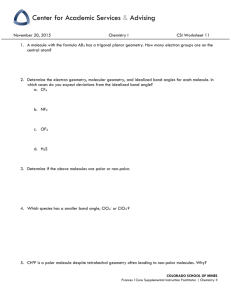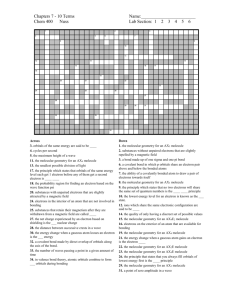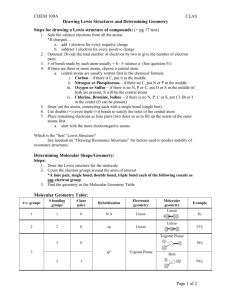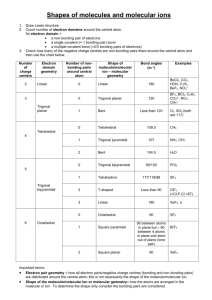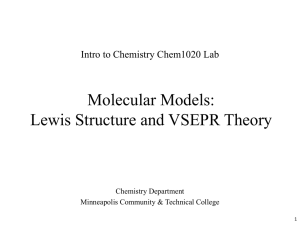Molecular Geometry and Bonding Theories
advertisement
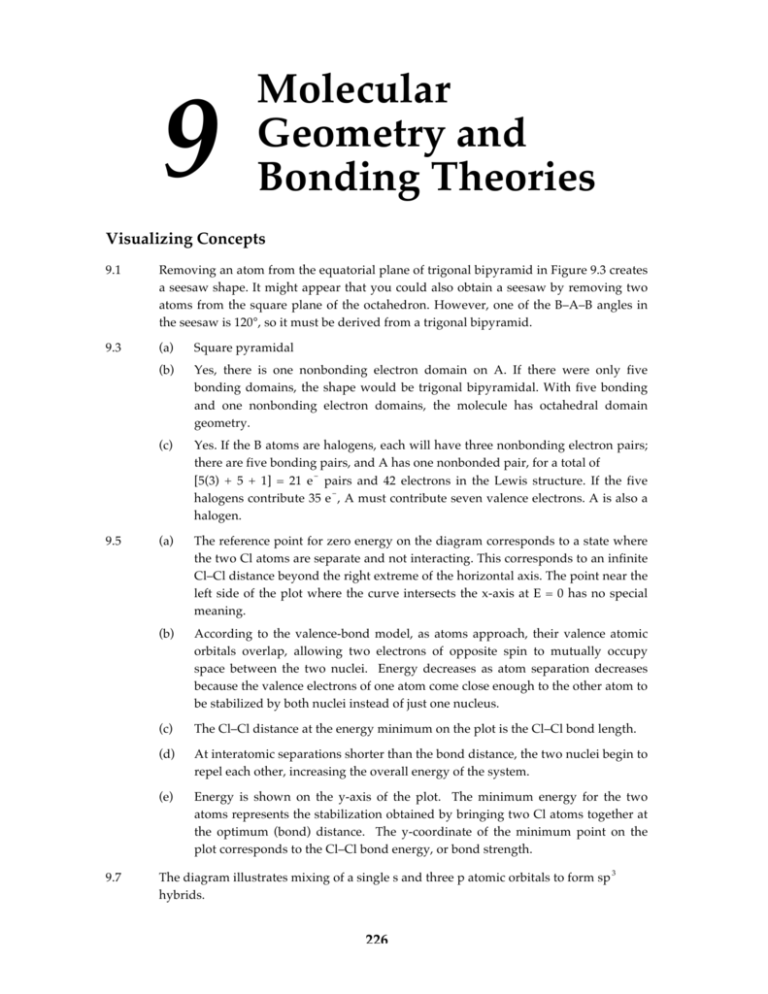
9 Molecular Geometry and Bonding Theories Visualizing Concepts 9.1 Removing an atom from the equatorial plane of trigonal bipyramid in Figure 9.3 creates a seesaw shape. It might appear that you could also obtain a seesaw by removing two atoms from the square plane of the octahedron. However, one of the B–A–B angles in the seesaw is 120°, so it must be derived from a trigonal bipyramid. 9.3 (a) Square pyramidal (b) Yes, there is one nonbonding electron domain on A. If there were only five bonding domains, the shape would be trigonal bipyramidal. With five bonding and one nonbonding electron domains, the molecule has octahedral domain geometry. (c) Yes. If the B atoms are halogens, each will have three nonbonding electron pairs; there are five bonding pairs, and A has one nonbonded pair, for a total of – [5(3) + 5 + 1] = 21 e pairs and 42 electrons in the Lewis structure. If the five – halogens contribute 35 e , A must contribute seven valence electrons. A is also a halogen. (a) The reference point for zero energy on the diagram corresponds to a state where the two Cl atoms are separate and not interacting. This corresponds to an infinite Cl–Cl distance beyond the right extreme of the horizontal axis. The point near the left side of the plot where the curve intersects the x-axis at E = 0 has no special meaning. (b) According to the valence-bond model, as atoms approach, their valence atomic orbitals overlap, allowing two electrons of opposite spin to mutually occupy space between the two nuclei. Energy decreases as atom separation decreases because the valence electrons of one atom come close enough to the other atom to be stabilized by both nuclei instead of just one nucleus. (c) The Cl–Cl distance at the energy minimum on the plot is the Cl–Cl bond length. (d) At interatomic separations shorter than the bond distance, the two nuclei begin to repel each other, increasing the overall energy of the system. (e) Energy is shown on the y-axis of the plot. The minimum energy for the two atoms represents the stabilization obtained by bringing two Cl atoms together at the optimum (bond) distance. The y-coordinate of the minimum point on the plot corresponds to the Cl–Cl bond energy, or bond strength. 9.5 9.7 The diagram illustrates mixing of a single s and three p atomic orbitals to form sp hybrids. 226 3 9 Molecular Geometry 9.9 Solutions to Exercises Analyze/Plan. σ molecular orbitals (MOs) are symmetric about the internuclear axis, π MOs are not. Bonding MOs have most of their electron density in the area between the nuclei, antibonding MOs have a node between the nuclei. (a) (i) The shape of the molecular orbital (MO) indicates that it is formed by two s atomic orbitals (electron density at each nucleus). (ii) σ-type MO (symmetric about the internuclear axis, s orbitals can produce only σ overlap). (iii) antibonding MO (node between nuclei) (b) (i) Shape indicates this MO is formed by two p atomic orbitals overlapping end-to-end (node near each nucleus). (ii) σ-type MO (symmetric about internuclear axis) (iii) bonding MO (concentration of electron density between nuclei) (c) (i) Shape indicates this MO is formed by two p atomic orbitals overlapping side-to-side (node near each nucleus). (ii) π-type MO (not symmetric about internuclear axis, side-to-side overlap) (iii) antibonding MO (node between nuclei) Molecular Shapes; the VSEPR Model 9.11 9.13 9.15 (a) Yes. The stated shape, linear, defines the bond angle (180°) and the A–B bond length tells the size. (b) No. Atom A could have 0, 2, 3 or 4 nonbonding electron pairs, depending on the total number of electron domains around atom A. (a) An electron domain is a region in a molecule where electrons are most likely to be found. (b) Each balloon in Figure 9.5 occupies a volume of space. The best arrangement is one where each balloon has its “own” space, where they are as far apart as possible and repulsions are minimized. Electron domains are negatively charged regions, so they also adopt an arrangement where repulsions are minimized. Analyze/Plan. Draw the Lewis structure of each molecule and count the number of nonbonding (lone) electron pairs. Note that the question asks ‘in the molecule’ rather than just around the central atom. Solve. (a) (CH3)2S, 20 valence e−, 10 e− pr, 2 nonbonding pairs (b) HCN, 10 valence e−, 5 e− pr, 1 nonbonding pair (c) H2C2, 10 valence e−, 5 e− pr, 0 nonbonding pairs 227 9 Molecular Geometry (d) Solutions to Exercises CH3F, 14 valence e−, 7 e− pr, 3 nonbonding pairs 9.17 The electron-domain geometry indicated by VSEPR describes the arrangement of all bonding and nonbonding electron domains. The molecular geometry describes just the atomic positions. H 2 O has the Lewis structure given below; there are four electron domains around oxygen so the electron-domain geometry is tetrahedral, but the molecular geometry of the three atoms is bent. 9.19 Analyze/Plan. See Tables 9.2 and 9.3. Solve. (d) 228 9 Molecular Geometry 9.21 Solutions to Exercises Analyze/Plan. Follow the logic in Sample Exercise 9.1. Solve. bent (b), linear (l), octahedral (oh), seesaw (ss), square pyramidal (sp), square planar (spl), tetrahedral (td), trigonal bipyramidal (tbp), trigonal planar (tr), trigonal pyramidal (tp), T-shaped (T) – *More than one resonance structure is possible. All equivalent resonance structures predict the same molecular geometry. + + _ + : + _ + 229 9 Molecular Geometry 9.23 9.25 9.27 Solutions to Exercises Analyze/Plan Work backwards from molecular geometry, using Tables 9.2 and 9.3. Solve. (a) Electron-domain geometries: i, trigonal planar; ii, tetrahedral; iii, trigonal bipyramidal (b) nonbonding electron domains: i, 0; ii, 1; iii, 2 (c) N and P. Shape ii has three bonding and one nonbonding electron domains. Li and Al would form ionic compounds with F, so there would be no nonbonding electron domains. Assuming that F always has three nonbonding domains, BF 3 and ClF 3 would have the wrong number of nonbonding domains to produce shape ii. (d) Cl (also Br and I, since they have seven valence electrons). This T-shaped molecular geometry arises from a trigonal bipyramidal electron-domain geometry with two nonbonding domains (Table 9.3). Assuming each F atom has three nonbonding domains and forms only single bonds with A, A must have seven valence electrons to produce these electron-domain and molecular geometries. It must be in or below the third row of the periodic table, so that it can accommodate more than four electron domains. Analyze/Plan. Follow the logic in Sample Exercise 9.3. Solve. (a) 1 – 109°, 2 – 109° (b) 3 – 109°, 4 – 109° (c) 5 – 180° (d) 6 – 120°, 7 – 109°, 8 – 109° Analyze/Plan. Given the formula of each molecule or ion, draw the correct Lewis structure and use principles of VSEPR to answer the question. Solve. The three nonbonded electron pairs on each F atom have been omitted for clarity. The F (axial) –A–F (equatorial) angle is largest in PF 5 and smallest in ClF 3 . As the number of nonbonding domains in the equatorial plane increases, they push back the axial A–F bonds, decreasing the F (axial) –A–F (equatorial) bond angles. 9.29 Analyze. Given: molecular formulas. Find: explain features of molecular geometries. Plan. Draw the correct Lewis structures for the molecules and use VSEPR to predict and explain observed molecular geometry. Solve. (a) – – – – BrF 4 36 e , 18 e pr – – BF 4 32 e , 16 e pr 230 9 Molecular Geometry Solutions to Exercises – 6 e pairs around Br – octahedral e domain geometry square planar molecular geometry – 4 e pairs around B, – tetrahedral e domain geometry tetrahedral molecular geometry The fundamental feature that determines molecular geometry is the number of electron domains around the central atom, and the number of these that are – – – bonding domains. Although BrF 4 and BF 4 are both of the form AX 4 , the central atoms and thus the number of valence electrons in the two ions are – different. This leads to different numbers of e domains about the two central atoms. Even though both ions have four bonding electron domains, the six total domains around Br require octahedral domain geometry and square planar molecular geometry, while the four total domains about B lead to tetrahedral domain and molecular geometry. (b) – – – – (H2O)4+, 4 e , 2 e p r H2O, 8 e , 4 e pr – 4 e pr around O – tetrahedral e domain geometry bent molecular geometry – 2 e pr around O – linear e domain and molecular geometry The shape of the (H2O)4+ molecular ion is linear. Polarity of Polyatomic Molecules 9.31 Analyze/plan. Follow the logic in Sample Exercise 9.4. Solve. (a) – SCl2, 20 e , 1 0 e pr – tetrahedral e domain geometry bent molecular geometry S and Cl have different electronegativities; the S−Cl bonds are polar. The bond dipoles are not opposite each other, so the molecule is polar. The dipole moment vector bisects the Cl−S−Cl bond angle. (A more difficult question is which end of the dipole moment vector is negative. The resultant of the two bond dipoles has its negative end away from S. However, the partial negative charge due to the lone pairs points opposite to the negative end of the resultant. A reasonable guess is that the negative end of the dipole moment vector is in the direction of the lone pairs.) (b) – – BeCl2, 16 e , 8 e p r 231 9 Molecular Geometry Solutions to Exercises linear electron domain and molecular geometry (Resonance structures with Be=Cl can be drawn, but electronegativity arguments predict that most electron density will reside on Cl and that the structure above is the main resonance contributor.) Be and Cl have very different electronegativities, so the Be−Cl bonds are polar. The individual bond dipoles are equal and opposite, so the net molecular dipole moment is zero. 9.33 9.35 (a) In Exercise 9.23, molecules ii and iii will have nonzero dipole moments. Molecule i has no nonbonding electron pairs on A, and the 3 A–F dipoles are oriented so that the sum of their vectors is zero (the bond dipoles cancel). Molecules ii and iii have nonbonding electron pairs on A and their bond dipoles do not cancel. A nonbonding electron pair (or pairs) on a central atom guarantees at least a small molecular dipole moment, because no bond dipole exactly cancels a nonbonding pair. (b) AF 4 molecules will have a zero dipole moment if there are no nonbonding electron pairs on the central atom and the 4 A–F bond dipoles are arranged (symmetrically) so that they cancel. Therefore, in Exercise 9.24, molecules i and ii have zero dipole moments and are nonpolar. Analyze/Plan. Given molecular formulas, draw correct Lewis structures, determine molecular structure and polarity. Solve. (a) Polar, ΔEN > 0 I–F (b) Nonpolar, the molecule is linear and the bond dipoles cancel. (c) Nonpolar, in a symmetrical trigonal planar structure, the bond dipoles cancel. (d) Polar, although the bond dipoles are essentially zero, there is an unequal charge distribution due to the nonbonded electron pair on P. (e) Nonpolar, symmetrical octahedron (f) Polar, square pyramidal molecular geometry, bond dipoles do not cancel. 232 9 Molecular Geometry 9.37 Solutions to Exercises Analyze/Plan. Follow the logic in Sample Exercise 9.4. Solve. (a) – – C2H2Cl2, each isomer has 24 e , 1 2 e p r . Lewis structures: Molecular geometries: (b) All three isomers are planar. The molecules on the left and right are polar because the C–Cl bond dipoles do not point in opposite directions. In the middle isomer, the C–Cl bonds and dipoles are pointing in opposite directions (as are the C–H bonds), the molecule is nonpolar and has a measured dipole moment of zero. (c) C2H3Cl (lone pairs on Cl omitted for clarity) There are four possible placements for Cl: By rotating each of these structures in various directions, it becomes clear that the four structures are equivalent; C2H3Cl has only one isomer. Because C2H3Cl has only one C−Cl bond, the bond dipoles do not cancel, and the molecule has a dipole moment. Orbital Overlap; Hybrid Orbitals 9.39 9.41 (a) Orbital overlap occurs when a valence atomic orbital on one atom shares the same region of space with a valence atomic orbital on an adjacent atom. (b) A chemical bond is a concentration of electron density between the nuclei of two atoms. This concentration can take place because orbitals on the two atoms overlap. (a) 4 valence e , 2 e pairs – – H—Mg—H – – 2 bonding e domains, linear e domain and molecular geometry (b) The linear electron domain geometry in MgH 2 requires sp hybridization. 233 9 Molecular Geometry (c) 9.43 Solutions to Exercises Mg Analyze/Plan. For entries where the molecule is listed, follow the logic in Sample Exercises 9.4 and 9.5. For entries where no molecule is listed, decide electron domain geometry from hybridization (or vice-versa). If the molecule is nonpolar, the terminal atoms will be identical. If the molecule is polar, the terminal atoms will be different, or the central atom will have one or more lone pairs, or both. Solve. Molecular Structures Electron Domain Geometry Hybrdization of CentralAtom Dipole Moment Yes or No CO2 linear sp no NH3 tetrahedral sp3 yes CH4 tetrahedral sp3 no BH3 trigonal planar sp2 no SF4 trigonal bipyramidal sp3d yes SF6 octahedral sp3d2 no H2CO trigonal planar sp2 yes trigonal bipyramidal sp3d no Molecule PF5 234 9 Molecular Geometry XeF2 9.45 Solutions to Exercises sp3d trigonal bipyramidal 2 no 1 (a) B: [He]2s 2p (b) The hybrid orbitals are called sp . 2 (c) (d) 9.47 A single 2p orbital is unhybridized. It lies perpendicular to the trigonal plane of 2 the sp hybrid orbitals. Analyze/Plan. Given the molecular (or ionic) formula, draw the correct Lewis structure and determine the electron domain geometry, which determines hybridization. Solve. (a) – – 24 e , 12 e pairs – – 2 3 e pairs around B, trigonal planar e domain geometry, sp hybridization (b) – – 32 e , 16 e pairs – – 3 4 e domains around Al, tetrahedral e domain geometry, sp hybridization (c) – – 16 e , 8 e pairs – – 2 e domains around C, linear e domain geometry, sp hybridization (d) – – 22 e , 11 e pairs – – 3 5 e pairs around Kr, trigonal bipyramidal e domain geometry, sp d hybridization (e) – – 48 e , 24 e pairs 235 9 Molecular Geometry Solutions to Exercises – – 3 2 6 e pairs around P, octahedral e domain geometry, sp d hybridization Multiple Bonds 9.49 (a) (c) (b) A σ bond is generally stronger than a π bond, because there is more extensive orbital overlap. (d) 9.51 Two s orbitals cannot form a π bond. A π bond has no electron density along the internuclear axis. Overlap of s orbitals results in electron density along the internuclear axis. (Another way to say this is that s orbitals have the wrong symmetry to form a π bond.) Analyze/Plan. Draw the correct Lewis structures, count electron domains and decide hybridization. Molecules with π bonds that require all bonded atoms to be in the same plane are planar. For bond-type counting, single bonds are σ bonds, double bonds consist of one σ and one π bond, triple bonds consist of one or two π bonds. Solve. (a) (b) sp3 sp2 sp (c) nonplanar planar planar (d) 7 σ, 0 π 5 σ, 1 π 3 σ, 2 π (e) Since Si has the same valence electron configuration as C, the structures of the Si analogs would be the same as the C-based molecules. The hybridization at Si is then the same as the hybridization at C. This argument assumes that the Si analogs exist. The fact that Si lies in the row below C means that Si has a larger bonding atomic radius and larger atomic orbitals than C. In the analogous compounds, Si−Si distances will be greater than C−C distances. It also means that the close approach of Si atoms required to form strong, stable π bonds in Si2H4 and Si2H2 is unlikely; Si−Si multiple bonds are unusual, possibly unknown. It is probably not true that Si2H4 and Si2H2 exist at “normal” (non-extreme) conditions. 9.53 Analyze/Plan. Single bonds are σ bonds, double bonds consist of 1 σ and 1 π bond. Each 236 9 Molecular Geometry Solutions to Exercises bond is formed by a pair of valence electrons. 9.55 9.57 Solve. (a) C 3 H 6 has 3(4) + 6(1) = 18 valence electrons (b) 8 pairs or 16 total valence electrons form σ bonds (c) 1 pair or 2 total valence electrons form π bonds (d) no valence electrons are nonbonding (e) The left and central C atoms are sp hybridized. 2 hybridized; the right C atom is sp 3 Analyze/Plan. Given the correct Lewis structure, analyze the electron domain geometry at each central atom. This determines the hybridization and bond angles at that atom. Solve. 3 (a) ~109° bond angles about the left most C, sp ; ~120° bond angles about the right2 hand C, sp (b) The doubly bonded O can be viewed as sp , the other as sp ; the nitrogen is sp with approximately 109° bond angles. (c) 9 σ bonds, 1 π bond (a) In a localized π bond, the electron density is concentrated strictly between the two atoms forming the bond. In a delocalized π bond, parallel p orbitals on more than two adjacent atoms overlap and the electron density is spread over all the atoms that contribute p orbitals to the network. There are still two regions of overlap, above and below the σ framework of the molecule. (b) The existence of more than one resonance form is a good indication that a molecule will have delocalized π bonding. 2 3 3 (c) The existence of more than one resonance form for NO 2 indicates that the π bond is delocalized. From an orbital perspective, the electron-domain geometry around 2 N is trigonal planar, so the hybridization at N is sp . This leaves a p orbital on N and one on each O atom perpendicular to the trigonal plane of the molecule, in the correct orientation for delocalized π overlap. Physically, the two N–O bond lengths are equal, indicating that the two N–O bonds are equivalent, rather than one longer single bond and one shorter double bond. Molecular Orbitals 9.59 (a) Hybrid orbitals are mixtures (linear combinations) of atomic orbitals from a single atom; the hybrid orbitals remain localized on that atom. Molecular orbitals are combinations of atomic orbitals from two or more atoms. They are associated with the entire molecule, not a single atom. (b) Each MO, like each AO or hybrid, can hold a maximum of two electrons. (c) Antibonding MOs can have electrons in them. 237 9 Molecular Geometry 9.61 Solutions to Exercises (a) (b) + There is one electron in H 2 . (c) (d) Bond order = 1/2 (1-0) = 1/2 (e) Fall apart. The stability of H 2 is due to the lower energy state of the σ bonding molecular orbital relative to the energy of a H 1s atomic orbital. If the single + electron in H 2 is excited to the σ* 1 s orbital, its energy is higher than the energy + of an H 1s atomic orbital and H 2 will decompose into a hydrogen atom and a hydrogen ion. (a) One. With three mutually perpendicular p orbitals on each atom, only one set can be oriented for end-to-end, sigma overlap. (b) Two. The 2 p orbitals on each atom not involved in σ bonding can be aligned for side-to-side π overlap. (c) Three, 1 σ* and 2 π*. There are a total of 6 p orbitals on the two atoms. When combining AOs to form MOs, total number of orbitals is conserved. If 3 of the 6 MOs are bonding MOs, as described in (a) and (b), then the remaining 3 MOs must be antibonding. They will have the same symmetry as the bonding MOs, 1 σ* and 2 π*. (a) When comparing the same two bonded atoms, the greater the bond order, the shorter the bond length and the greater the bond energy. That is, bond order and bond energy are directly related, while bond order and bond length are inversely related. When comparing different bonded nuclei, there are no simple relationships (see Solution 8.95). + 9.63 9.65 238 9 Molecular Geometry (b) Be 2 , 4 e Solutions to Exercises – + Be 2 , 3 e BO = 1/2(2-2) = 0 – BO = 1/2(2-1) = 0.5 Be 2 has a bond order of zero and is not energetically favored over isolated Be + atoms; it is not expected to exist. Be 2 has a bond order of 0.5 and is slightly lower in energy than isolated Be atoms. It will probably exist under special experimental conditions, but be unstable. 9.67 (a), (b) Substances with no unpaired electrons are weakly repelled by a magnetic field. This property is called diamagnetism. 2– 2+ (c) O 2 , Be 2 [see Figure 9.46 and Solution 9.65 (b)] (a) B2 (b) increase 9.69 + + Li 2 (c) increase + N2 (d) increase 2+ Ne 2 decrease Addition of an electron increases bond order if it occupies a bonding MO and decreases stability if it occupies an antibonding MO. 9.71 Analyze/Plan. Determine the number of “valence” (non-core) electrons in each molecule or ion. Use the homonuclear diatomic MO diagram from Figure 9.43 (shown below) to calculate bond order and magnetic properties of each species. The electronegativity difference between heteroatomics increases the energy difference between the 2s AO on one atom and the 2p AO on the other, rendering the “no interaction” MO diagram in Figure 9.43 appropriate. Solve. 239 9 Molecular Geometry Solutions to Exercises – CN: 9 e , B.O. = (7 – 2) / 2 = 2.5 + 8 e , B.O. = (6 – 2) / 2 = 2.0 – – 10 e , B.O. = (8 – 2) / 2 = 3.0 CN : CN : 9.73 – (a) CN− has the highest bond order and therefore the strongest C−N bond. (b) CN and CN+. CN has an odd number of valence electrons, so it must have an unpaired electron. The electron configuration for CN is shown in the diagram. Removing one electron from the π2p MOs to form CN+ produces an ion with two unpaired electrons. Adding one electron to the π2p MOs of CN to form CN− produces an ion with all electrons paired. (a) 3s, 3p x , 3p y , 3p z (d) If the MO diagram for P 2 is similar to that of N 2 , P 2 will have no unpaired electrons and be diamagnetic. (b) (c) π3p Two Additional Exercises 9.76 – e domain geometry td molecular shape td tbp seesaw (ss) octahedral (oh) square planar (s) Although there are four bonding electron domains in each molecule, the number of nonbonding domains is different in each case. The bond angles and thus the molecular shape are influenced by the total number of electron domains. 9.79 – (a) CO 2 , 16 valence e (c) H 2 CO, 12 valence e – 240 – – (b) NCS , 16 valence e (d) HCOOH, 18 valence e – 9 Molecular Geometry Solutions to Exercises 9.81 BF 3 is a trigonal planar molecule with the central B atom symmetrically surrounded by the three F atoms (Figure 9.13). The individual B–F bond dipoles cancel, and the molecule has a net dipole moment of zero. PF 3 has tetrahedral electron-domain geometry with one of the positions in the tetrahedron occupied by a nonbonding electron pair. The individual P–F bond dipoles do not cancel and the presence of a nonbonding electron pair ensures an asymmetrical electron distribution; the molecule is polar. 9.85 9.87 (a) The molecule is not planar. The CH 2 planes at each end are twisted 90° from one another. (b) Allene has no dipole moment. (c) The bonding in allene would not be described as delocalized. The π electron clouds of the two adjacent C=C are mutually perpendicular. The mechanism for delocalization of π electrons is mutual overlap of parallel p atomic orbitals on adjacent atoms. If adjacent π electron clouds are mutually perpendicular, there is no overlap and no delocalization of π electrons. (a) To accommodate the π bonding by all 3 O atoms indicated in the resonance 2 structures above, all O atoms are sp hybridized. 2 (b) For the first resonance structure, both sigma bonds are formed by overlap of sp hybrid orbitals, the π bond is formed by overlap of atomic p orbitals, one of the nonbonded pairs on the right terminal O atom is in a p atomic orbital, and the 2 remaining five nonbonded pairs are in sp hybrid orbitals. (c) Only unhybridized p atomic orbitals can be used to form a delocalized π system. (d) The unhybridized p orbital on each O atom is used to form the delocalized π system, and in both resonance structures one nonbonded electron pair resides in 241 9 Molecular Geometry Solutions to Exercises a p atomic orbital. The delocalized π system then contains four electrons, two from the π bond and two from the nonbonded pair in the p orbital. 9.91 (a) N2 in the first excited state has two unpaired electrons and is paramagnetic. (b) N2 in the ground state has a B.O. of 3; in the first excited state (at left) it has a B.O. of 2. Owing to the reduction in bond order, N2 in the first excited state has a weaker (and longer) N−N bond than N2 in the ground state. 9.97 (a) 2SF 4 (g) + O 2 (g) → 2OSF 4 (g) (b) 40 e , 20 e pairs – – There must be a double bond drawn between O and S in order for their formal charges to be zero. (c) ΔH = 8D(S–F) + D(O=O) – 8D(S–F) – 2D(S=O) ΔH = D(O=O) – 2D(S=O) = 495 – 2(523) = –551 kJ, exothermic 9.99 (d) trigonal bipyramidal electron-domain geometry (e) Because F is more electronegative than O, the structure that minimizes S–F repulsions is more likely (see Solution 9.98). That is, the structure with fewer 90° F–S–F angles and more 120° F–S–F angles is favored. The structure on the left, with O in the axial position is more likely. Note that a double bond involving an atom with an expanded octet of electrons, such as the S=O in this molecule, does not have the same geometric implications as a double bond to a first row element. (a) Three electron domains around each central C atom, sp hybridization (b) A 180° rotation around the C=C double bond is required to convert the trans isomer into the cis isomer. A 90° rotation around the bond eliminates all overlap of the p orbitals that form the π bond and it is broken. 2 (c) average bond enthalpy C=C 614 kJ/mol C–C 348 kJ/mol 242 9 Molecular Geometry Solutions to Exercises The difference in these values, 266 kJ/mol, is the average bond enthalpy of a C–C π bond. This is the amount of energy required to break 1 mol of C–C π bonds. The energy per molecule is (d) (e) Yes, 450 nm light is in the visible portion of the spectrum. A cis-trans isomerization in the retinal portion of the large molecule rhodopsin is the first step in a sequence of molecular transformations in the eye that leads to vision. The sequence of events enables the eye to detect visible photons, in other words, to see. 9.101 ΔH = 6D(C–H) + 3D(C–C) + 3D(C=C) – 0 = 6(413 kJ) + 3(348 kJ) + 3(614 kJ) = 5364 kJ (The products are isolated atoms; there is no bond making.) According to Hess’ law: = 6(718.4 kJ) + 6(217.94 kJ) – (82.9 kJ) = 5535 kJ The difference in the two results, 171 kJ/mol C 6 H 6 is due to the resonance stabilization in benzene. That is, because the π electrons are delocalized, the molecule has a lower overall energy than that predicted for the presence of 3 localized C–C and C=C bonds. Thus, the amount of energy actually required to decompose 1 mole of C 6 H 6 (g), represented by the Hess’ law calculation, is greater than the sum of the localized bond enthalpies (not taking resonance into account) from the first calculation above. 9.103 (a) (b) Ignoring the donut of the orbital 243 9 Molecular Geometry Solutions to Exercises (c) A node is generated in because antibonding MOs are formed when AO lobes with opposite phases interact. Electron density is excluded from the internuclear region and a node is formed in the MO. (d) Sc: [Ar]4s 3d Omitting the core electrons, there are six e in the energy level diagram. (e) The bond order in Sc 2 is 1/2 (4 – 2) = 1.0. 2 1 – 244
